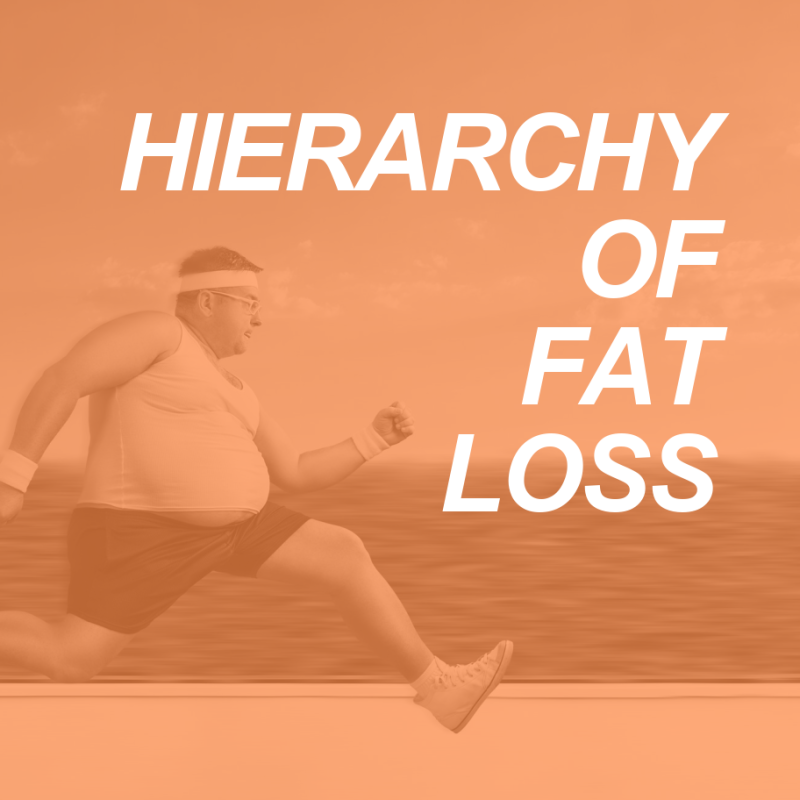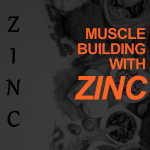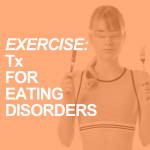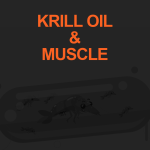
Fat loss training can be very confusing for our personal training clients and even for their coaches, but it doesn’t have to be. Unfortunately, a common belief held by many of our clients is that more cardio is best, and the longer the workouts the better results you will have. This notion is not only false but also a colossal waste of time. Instead, focus on the most important elements of fat loss regardless of how much time your clients can commit to fat loss. Let’s eliminate the confusion and follow the hierarchy of fat loss.
The Hierarchy of Fat Loss
1. Correct Nutrition
You can’t out-train a poor diet. You need to achieve a calorie deficit while taking in adequate proteins (to preserve muscle) and essential fats in your nutrition plan. It may sound over-simplistic but the difference between building muscle mass and burning body fat is determined by your diet. Make nutrition king for fat loss. Nutrition is so powerful that you can achieve fat loss without exercise. However, bear in mind striking the ideal balance is not always simple; chronically underconsuming calories (as many people are bound to do) can absolutely undercut fat loss and muscle building.
2. See #1
Nutrition is that important and worth stating again. Nutrition is so much more powerful in comparison to exercise. Doing exercise without addressing diet does not make any sense and is like building a house without a foundation. Get your diet in place first before adding anything else.
3. Include activities that build muscle mass and elevate metabolism
The calories burned during your workout are only a fraction compared to what’s burned by resting metabolic rate (RMR). A higher RMR is largely correlated with lean muscle tissue. Adding activities that build or maintain muscle mass will make the body work harder and will increase metabolic rate. The more muscle tissue, the harder the body has to work to maintain muscle than it does to maintain fat tissue thus elevating your metabolism. This is why doing activities that build muscle tissue will take precedence over other modalities of exercise.
4. Include activities that burn calories and elevate metabolism
Next, you want to perform similar activities that focus on burning more calories and increasing EPOC (Excess Post Oxygen Consumption). During EPOC, the body uses oxygen to restore muscle glycogen and rebuild muscle proteins damaged during exercise. After a High-Intensity Interval Training (HIIT) workout, for example, the body has to work hard to return to homeostasis levels of pre-exercise; this increases the body’s brown fat stores, increasing thermogenesis, and can add an additional 250-300 calories burned a day. This process can require several hours with intense exercise or minutes with low-intensity exercise. Focus your efforts on activities that will keep your body burning more calories even after the workout.
5. Include activities that simply burn calories
Lastly, these are activities that are considered the “extra.” These are the least effective as they only burn calories during a workout, or even during your day, but do not elevate metabolism. Moving more throughout the day and reducing sedentary time will burn more calories throughout the day, known as non-exercise activity thermogenesis, or NEAT. Walking, moving, moving faster, etc. will promote fat loss to some extent. However, the impact will not be as great as the first four for maximizing fat loss.
The Top Five Fat Loss Training Methods
1. Metabolic Resistance Training
When it comes to fat loss programming, make resistance training the key focus. Work multijoint movements (multi-muscle groups involved) instead of single-joint (isolated) movements. Remember to add intensity and enough frequency to cause a metabolic disturbance to elevate metabolism after the workout. The most effective aspects of metabolic resistance training include weight lifting, circuits, full-body workouts, and training for hypertrophy (8-12 repetitions have been found to work best with occasional higher repetitions).
2. High-Intensity Anaerobic Interval Training
The second key in fat loss programming is high-intensity interval training (HIIT). It elevates metabolism significantly more than other forms of cardio and it burns more calories than steady-state cardio.
3. High-Intensity Aerobic Interval Training
The third key in fat loss programming is high-intensity aerobic interval training. Think short “sprints” coupled with recovery time. Interval work appeared to “upregulate” fat-burning enzymes. This means we can burn more fat in other activities as a result.
4. Steady-State High-Intensity Aerobic Training
The fourth key is plain, old hard cardio. This form is about burning calories. The intensity is not high enough to increase EPOC significantly or to do anything beyond the session itself. However, calories do add up.
5. Steady-State Low-Intensity Activity
The fifth key is low-intensity aerobic training. An example of this would be going for a walk; you won’t burn a lot of calories, and it won’t increase muscle or EPOC. Every little bit counts however and it’s never a bad idea to move more often.
Prioritizing Time Management for Fat Loss
When coaching clients on how to prioritize which activities to utilize to reach their fat loss goals, start with an honest assessment of how much time they can dedicate to their endeavor, and advise accordingly:
-If they have 3 hours per week, use only #1: Metabolic resistance training.
-If they have 3-5 hours per week use #1 and #2: Weight training plus high-intensity interval resistance work. (Three hours to resistance training, 1-2 hours for interval work)
-If they have 5-6 hours add #3: Aerobic interval training.
-If they have more time than that add # 5: Steady-state low-intensity activity.
Fat Loss made Simple
Always remember that nutrition is the most crucial component in achieving fat loss. When considering exercise’s role in losing fat, incorporate shorter more intense workouts rather than longer less intense workouts. Help clients prioritize what’s important, as they may be limited on time. Follow this hierarchy of fat loss can provide structure and guidance for those struggling to implement the most beneficial activities.
References
Cosgrove, A. (2007, April 11). The Hierarchy of Fat Loss.








